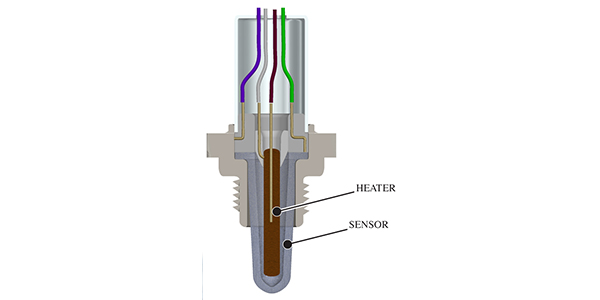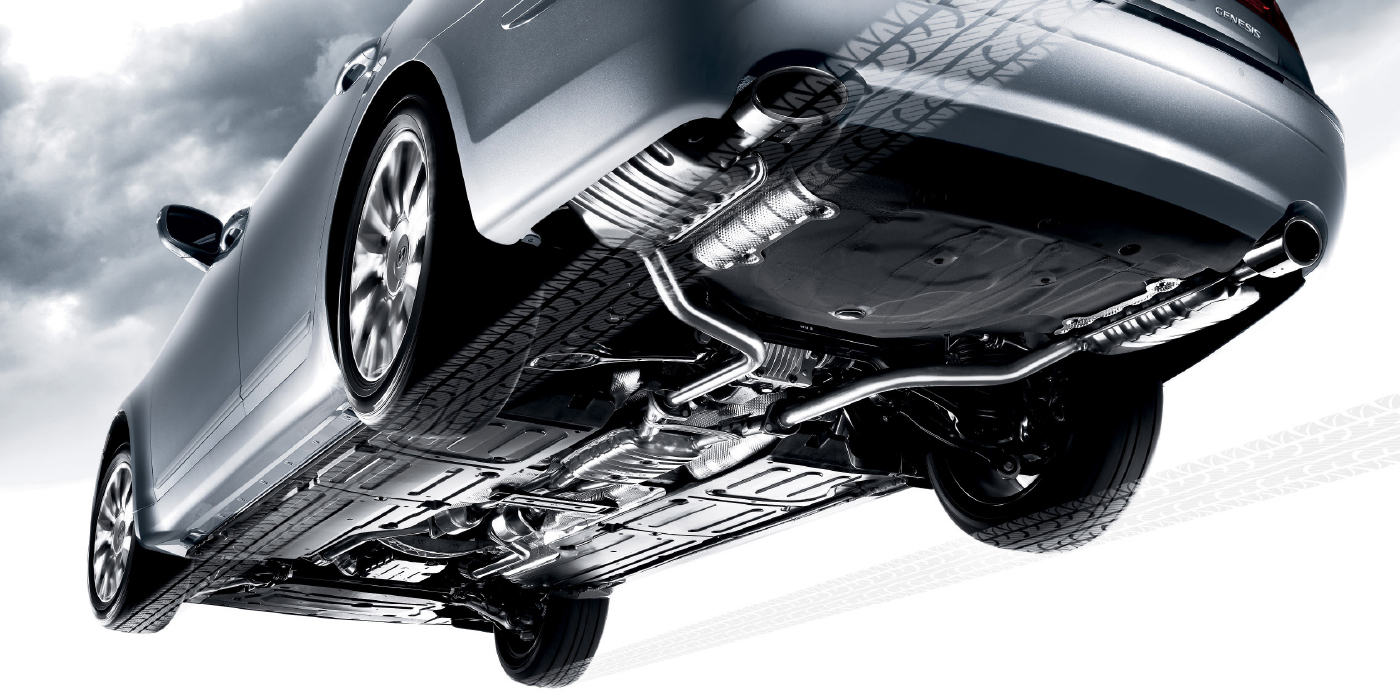After 10-plus years of dealing with OBD II, it should be apparent that we are on a learning curve that probably has no end. Almost daily we have a Volkswagen model come into the shop with a check engine light on, or a “state OBD II failure” form. Although we have the latest scanner software packages, some of these failures can still be elusive to resolve.
In this article, I’ll revisit some of the more common failures that we continue to see and how we resolved them, saving you time and cost for your customer. As always, throwing parts at a problem is not the best tool for OBD repairs. Knowing how a component is designed to work is always the first step in locating a failure.
Whatever the reason for the MIL to be on, there was a sequence of events that lead the ECM to conclude there was a problem. A visual inspection should always be the first step in any diagnostic procedure. After pulling codes in the case of an OBD failure, a look at the system involved just might turn up an obvious fault without any test equipment.
Tool Time
The most important element of VW OBD II repair is having the right equipment. You need to not only pull codes, but be able to track data and perform at least basic activations to test systems’ operation. To make repairs, you will need to locate the cause before replacing parts. As the parameters for components get narrower, the need for more accurate data becomes paramount. When choosing from among the number of scanners available on the market, make sure whatever you get is upgradeable.
While on the subject of scanners, be sure to protect yourself and your equipment. Purchase a small VAG tester (Volkswagen AG) — a little tool that works on virtually any vehicle and should be used before connecting to any OBD II car with aftermarket equipment installed. We’ve seen many cases where shortly after the installation of a stereo, phone or other equipment, communication was lost with the ECU. With improper attachment to OBD wiring, a backfeed from that equipment can not only take out the car’s computer, but your scanner as well. If you use one of these testers, a red indicator can save time and make you money.
With Volkswagen cars, having a scanner with the capability to pull codes and data from earlier OBD I cars can also add to your bottom line. With the twin-lead (white and black) adaptor, you can access codes on some models that are nearly 20 years old.
A DVOM or graphing multimeter will also be a great help in diagnosis. We often have more than one meter set up on a single component to watch both input and output data when tracing difficult faults. Most of the test procedures for resolving OBD faults on VWs involve the use of a test box or breakout box. With a good wiring diagram and the proper probes, the tests can be performed without the box, at the component or at the ECM. We very often have to search several databases or contact tech support for the specific information we need to test individual components for proper input and output parameters.
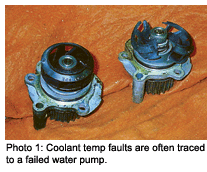 DTC P0116, 117, 118, 125 — Engine Coolant Temp Sensor (ECT) Out of Range
DTC P0116, 117, 118, 125 — Engine Coolant Temp Sensor (ECT) Out of Range
This set of codes is almost always accompanied by a report of overheating. The most common cause is water pump failure. See Photo 1. Start by looking for obvious coolant leaks, low coolant level or other signs of overheating. Certainly check the ECT for resistance values; replace if it’s out of specification. If the coolant level is low, determine the source of leakage and make the repair. See Photo 2.
Remember, if there are symptoms of high engine heat when driving, but the temperature is OK at idle, the most likely candidate is the water pump.
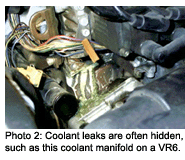 DTC P0120, 121, 122, 221, 507 and More — Throttle Control Module Faults
DTC P0120, 121, 122, 221, 507 and More — Throttle Control Module Faults
Probably the most common cause of these faults is tampering. For most VW models after 1996, the throttle angle is controlled electronically. The cable going to the throttle body is for cruise control, not throttle operation. Throttle angle is calculated by the ECM reading the angle at the pedal position sensor, vehicle speed, gear position and other factors. Simply opening the throttle by hand under the hood with the engine running can cause codes to set. Most often, the cause is an attempt to change idle speed by changing the base setting of the throttle plate, either by adjusting the stop screw or adding a shim to hold the cable linkage from closing. See Photo 3.
 After determining the extent of the tampering, you will need to perform a throttle valve control module (TVCM) adaption procedure to synchronize the throttle to the pedal position sensor. Many models do this automatically if the key is turned on without starting for 10 seconds. Cars with automatic transmissions also need to have the transmission control module basic setting procedure done any time the throttle control module is adapted.
After determining the extent of the tampering, you will need to perform a throttle valve control module (TVCM) adaption procedure to synchronize the throttle to the pedal position sensor. Many models do this automatically if the key is turned on without starting for 10 seconds. Cars with automatic transmissions also need to have the transmission control module basic setting procedure done any time the throttle control module is adapted.
If the TVCM adaption cannot be completed after several attempts, and a thorough cleaning of the throttle body, the only solution may involve replacement of the throttle control module — an expensive part. The factory adjustments could probably be repeated, if all you have is a lot of free time. Make sure all other basics, such as vacuum leaks and mechanical faults that could have caused the tampering attempt, are resolved before taking this step.
DTC P0300, 301, 302, etc. — Misfire Detection
Stop! Before you even open the hood, check the fuel gauge. Is the gauge at E or F? Was the car recently run low on fuel, and then filled before being brought into the shop? These faults can be set due to low fuel level; another code (P1250) may also be set whenever there is less than two gallons of fuel in the tank.
If those symptoms are not the case, or the customer won’t admit to being at fault, go under the hood. Pull a spark plug, inspect its condition and evidence of fouling. There are many possibilities for misfire problems but, in many cases, lack of maintenance is the main cause. We get too many of these cars into our shop, after someone has changed injectors, coils, ECMs or made major mechanical repairs, only to find that a cracked distributor cap, serious carbon tracks or the wrong spark plugs were the cause of the MIL illumination. With OBD II, usually there will be specific codes for major component failures, like injectors.
DTC P0411 — Secondary Air Injection System Incorrect Flow Detected
This code comes up almost daily. The typical cause is the failure of the vacuum hose to the check valve (combi-valve) on the exhaust manifold. Just like EGR vacuum hoses have cracked and fallen off for years, this hose lives in a harsh environment not meant for rubber hose covered with cloth. Here’s the diagnostic procedure for this code.
Start the cold engine and listen for the “vacuum cleaner” sound of the secondary air pump. The pump should run for up to 100 seconds during any cold start, and may run even after a warm start or after an extended idle.
If the pump runs, isn’t too noisy and shuts off after a couple of minutes, start tracing the hoses from and to the pump, and locate the check valve.
Inspect the small hose to the valve. Just touching it at the valve connection will usually verify the failure (the valve may be a little warm!).
If the hose has failed, replace it, preferably with a silicone hose of the correct size to prevent leakage and repeat failure.
With your scanner set to activations, run the pump relay, pump and control valve tests. Use a vacuum pump to make sure the check valve is not damaged (stuck open or closed).
If the pump is excessively noisy (experience is the best determining factor; they all make some noise), inspect the inlet hose for any signs of water entry. This is especially troublesome on models that have the pump mounted low in the engine compartment and draw air from the air cleaner. Like a vacuum cleaner, water getting into the pump will kill it in short order. The pump can also be damaged by exhaust getting past a stuck check valve. Always determine the cause of the pump failure before replacement, so the new pump isn’t immediately damaged.
DTC P0440, 441, 1410, 1425, 1426 — EVAP Faults
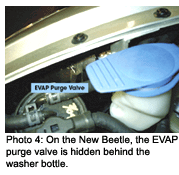 This is an obvious one for all cars. The first step is to always go to the fuel filler and check for a missing or incorrectly installed cap. It’s amazing to me that there are people who still don’t know about making the cap “click” when installing. A cap tester should be used next whenever there is not an obvious “operator error.” At this point, probably more than 90% of EVAP faults should be resolved. The next step with Volkswagen vehicles is to get the scanner out and test operation of the canister purge valve (see Photo 4) through the activation function. This valve is usually buried in the passenger side of the engine compartment, so this is the easiest way to check to see if it works. If the valve is working, clear the code and take the car on a test drive; if the code doesn’t reset,
This is an obvious one for all cars. The first step is to always go to the fuel filler and check for a missing or incorrectly installed cap. It’s amazing to me that there are people who still don’t know about making the cap “click” when installing. A cap tester should be used next whenever there is not an obvious “operator error.” At this point, probably more than 90% of EVAP faults should be resolved. The next step with Volkswagen vehicles is to get the scanner out and test operation of the canister purge valve (see Photo 4) through the activation function. This valve is usually buried in the passenger side of the engine compartment, so this is the easiest way to check to see if it works. If the valve is working, clear the code and take the car on a test drive; if the code doesn’t reset, 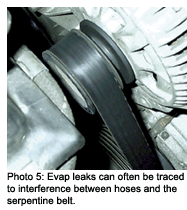 you’re finished. If it does reset, there may still be a leak, so get your smoke machine out and start pumping the system full of smoke and repair any leaks as needed. The place to look on most models up to 1999 is the collection of hoses near the passenger side of the engine compartment. These hoses are often not clipped into place and rub through on the accessory belt. (See Photo 5).
you’re finished. If it does reset, there may still be a leak, so get your smoke machine out and start pumping the system full of smoke and repair any leaks as needed. The place to look on most models up to 1999 is the collection of hoses near the passenger side of the engine compartment. These hoses are often not clipped into place and rub through on the accessory belt. (See Photo 5).
DTC P1127, 1128, 1137 — HO2 Sensor, Upstream TWC, Long-Term Fuel Trim Faults
Check tune-up basics first and for lack of maintenance. A plugged air filter, secondary air system problems or a bad MAF sensor can also cause these codes to set. This is one case where other components may cause the MIL to come on without setting a hard fault.
VW has had some problems with O2 and MAF sensors on some models, and replacements are often priced low enough to replace them as a maintenance upgrade for problem cars. Standard tests for operation of up- and downstream O2 sensors should indicate a problem and solution. If the O2 sensors seem to be operating correctly, replacing the MAF, even if there is no specific code, may be the solution.
VW ends all of its diagnostic and repair procedures with a “Test Drive Re-learn Procedure.” This can be accomplished in several ways. You can use your scanner, from a cold start and go through a step-by-step process to set basic settings, readiness codes and then check for any recurring codes. You can also take the car on a road trip, completing a designated drive cycle, and then recheck for codes. Or you can return the car to the customer with this advice: The car will need to be driven from a cold start for a minimum of an hour, or 50 miles, varying the speed and throttle angle, without turning off the ignition.
Final Thoughts
My procedure is to perform the basic setting procedure for the specific model and engine code, road test and recheck for codes. Return the car to the customer with the recommendation to take a road trip of at least 50 miles from a cold start. This procedure should reset all of the readiness monitors. Our shop is located in Washington, and even our state’s emissions department recommends that after an OBD II failure, a car should not return to the inspection station for a retest until it has been driven for awhile, usually a couple of days. They will not retest a car with more than one readiness flag not completed.
As emissions regulations continue to tighten, education and hands-on experience will be the factors that make or break our ability to perform repairs that will ensure a clean environment for our children. Learning to correctly repair emissions problems, and then educating our customers to maintain and service their vehicles, should be the focus of everyone in our industry.
| Did You Know… Having a good service history on a particular car often helps in determining the cause of some failures. Driving habits often can lead to repeat failures. So don’t be fooled by a car that is still running OK even with the light on. VW has done a great job of making its vehicles still run pretty well, even in “limp mode.”
The “P” Codes… P codes relate to Powertrain control malfunctions. DTCs that start with P0 are federally mandated control parameters, and should be accessible with any scanner, but may provide only basic interpretation and may not be much help other than pointing you in a general direction for diagnosis. DTCs starting with P1 are manufacturer-specific codes that may not always be interpreted by a generic scanner. From there, the numbers narrow the scope of the DTC to a particular control parameter, and then a specific component. Volkswagen cars can also have five-number, VW-specific DTCs that have no OBD II match. This is why having a scanner that can access VW-specific information can be a time saver if you work on many of these vehicles. Free Technical Data… When it comes to Hyundais, there’s no reason not to have all the information you need via free access to the Hyundai website (www.hmaservice.com). Use this free diagnostic information to save you time on a tough problem that may have already been identified and taken care of with a TSB or re-flash. |
Code-Breaking For Hyundais
As import car techs, we can’t ignore Korean-made cars: They’re making the same inroads into the market that the Japanese cars did in the late ‘70s and early ‘80s. By providing good value, quality cars and strong warranties, there’s no reason to think they won’t enjoy the same success. Let’s take a look at some problems you may face with Hyundai’s line of cars, with an eye toward driveability and check engine problems.
Misfire
The most common code we see is the P0300 series of misfire codes. All automakers have gone to coil packs or coil-on-plug systems on their vehicles to better control misfire. I’m sure we’re all familiar with these systems, but it can’t hurt to remind ourselves and our techs what to watch for that will prevent problems in the future and help diagnose a misfire code.
Whenever the coils or wires are removed to service the plugs, take the time to clean and inspect the plug boots and do a good visual inspection with an eye toward spark leakage. The same tactic will be necessary and valuable as you diagnose misfire codes. While you can look at the secondary ignition with KV modules and low-amp probes, spark leakage to the plug tube will do a good job of mimicking a spark gap, possibly sending you in the wrong direction.
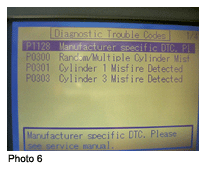 Don’t overlook checking the condition of the spark plugs; these cars run so well it’s easy for the customer to overlook some recommended service. This is a good opportunity to point out that better maintenance practices pay dividends and may have avoided this problem. At the very least, we want to be sure that our new ignition parts aren’t being over-taxed by worn-out spark plugs.
Don’t overlook checking the condition of the spark plugs; these cars run so well it’s easy for the customer to overlook some recommended service. This is a good opportunity to point out that better maintenance practices pay dividends and may have avoided this problem. At the very least, we want to be sure that our new ignition parts aren’t being over-taxed by worn-out spark plugs.
On an Accent we were diagnosing, we had P0300, P0301 and P0303 codes indicating random as well as cylinder one and three misfires (see Photo 6), along with a P1128 system lean code (see Photo 7). In these instances, I go after the misfire codes first since the lean code could be a result of the misfires and high oxygen content in the exhaust. In this case, we repaired the misses with wires and plugs, and monitored long-term trim to confirm the parameters weren’t exceeded.
Lean and Mean
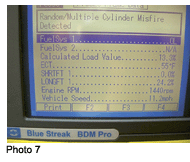 After misfire codes, the lean code is another frequent issue we see, often with no driveability complaint. While some folks refer to this as an oxygen sensor code, I would warn against jumping to conclusions. If the sensor seems to operate well but is biased lean, it’s a good indication that the engine is indeed lean and the sensor is doing its job by reporting that information.
After misfire codes, the lean code is another frequent issue we see, often with no driveability complaint. While some folks refer to this as an oxygen sensor code, I would warn against jumping to conclusions. If the sensor seems to operate well but is biased lean, it’s a good indication that the engine is indeed lean and the sensor is doing its job by reporting that information.
Again, it’s back to the basics, looking for vacuum leaks or unmetered air entering the engine. There have been plenty of reports of dirty mass air flow sensors causing this code. It can be tough to confirm a bad sensor, but if you have a labscope, this is a good place to use it; Look for voltage dropouts and output during snap throttle tests. Be sure to check for TSBs as Hyundai has come out with expected numbers that can be monitored on most scan tools.
Armed with freeze-frame data and good service information, you should be able to recommend a new sensor with confidence. Some techs report good success with careful cleaning of the mass air flow sensor. I can’t say I’ve had that experience, and would recommend cleaning only as a diagnostic step. If cleaning makes it better, install a new unit and be sure all the incoming air is filtered through a high-quality part.

